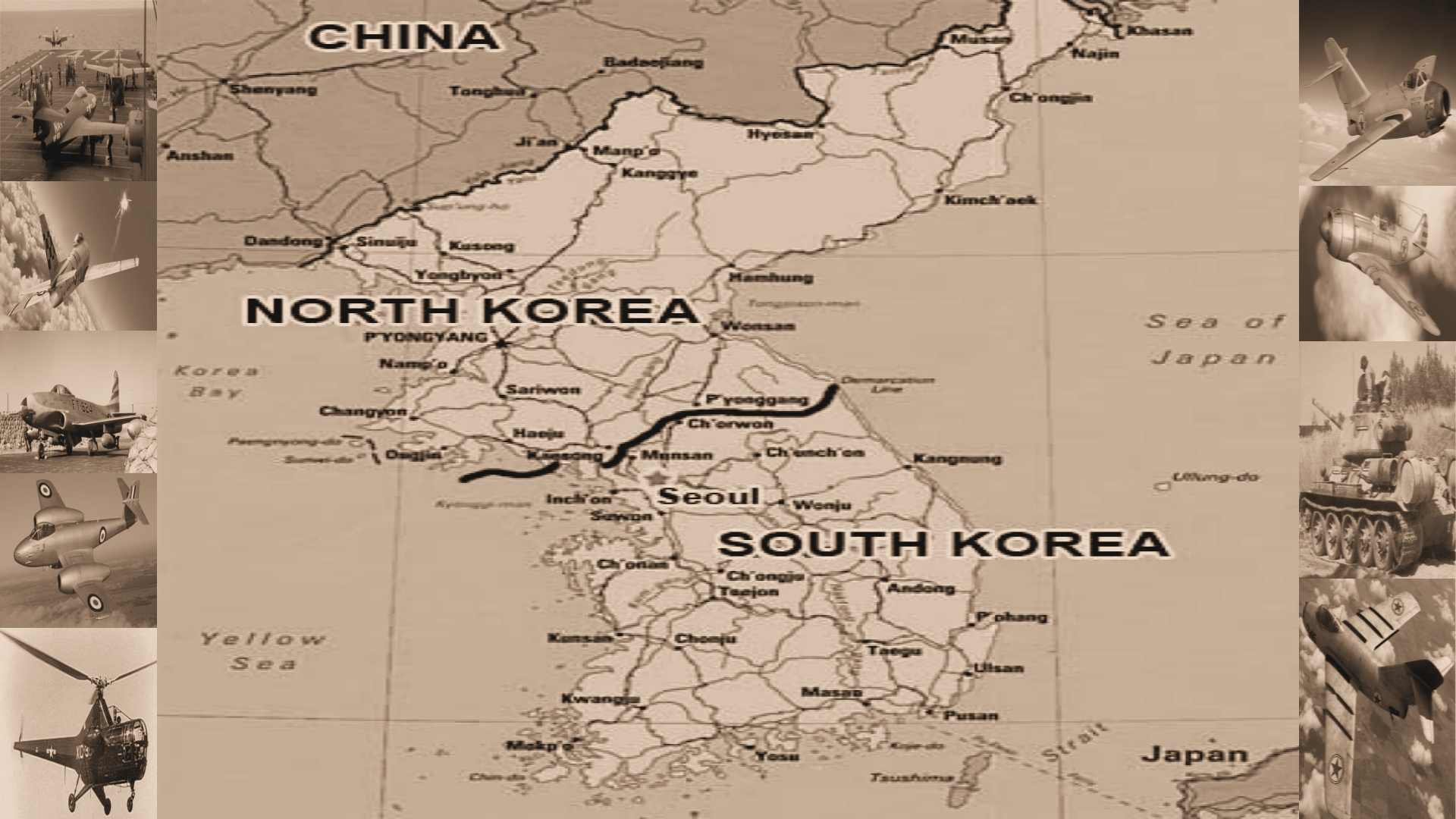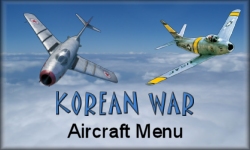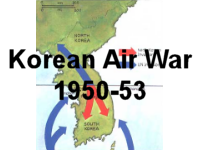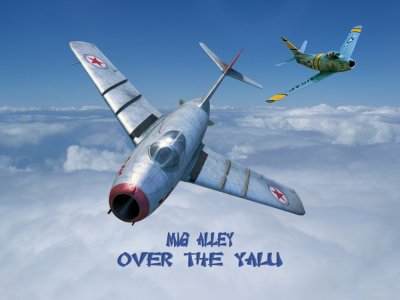



|

|

|

Korean Conflict Air War June 1950 - July 1953
North Korea Invades
The Korean Conflict(also known as a 'Police Action') was the first war in which jet aircraft played a central role. Once-formidable fighters such as the P-51D 'Mustang', F4U 'Corsair', and the new Hawker Sea Fury, all piston-engined, propeller-driven, and designed during World War II relinquished their air-superiority roles to a new generation of faster, jet-powered fighters arriving in the theater. For the initial months of the war, the F-80 'Shooting Star', F9F 'Panther', and other jets under the UN flag dominated North Korea's prop-driven air force of Soviet Yakovlev Yak-9 and Lavochkin La-9s. The balance would shift with the arrival of the swept-wing Soviet built MiG-15, one of the world's most advanced jet fighters. The Chinese intervention in late October 1950 bolstered the Korean People's Air Force (KPAF) of North Korea with the MiG-15 as well. The fast, heavily armed MiG outflew first-generation UN jets such as the F-80 (United States Air Force) and Gloster Meteors (Royal Australian Air Force) posing a real threat to B-29 Superfortress bombers even under fighter escort. Soviet Air Force pilots flew missions for the North to learn the West's aerial combat techniques. The United States Air Force had 1,172 aircraft in the Pacific region at the time of the outbreak of the Korean War, including squadrons of F-80 Shooting Stars as well as numerous F-82 Twin Mustangs, A-26 'Invaders', B-29 'Superfortresses', among others. Hundreds of aircraft were available in Japan to be immediately mustered against the North Korean invasion, many of them the newest jet engine-powered fighter aircraft. For the US Navy flying support, the F9F Panther was the most widely used U.S. Navy jet fighter of the Korean War, flying 78,000 sorties, supported by the McDonnell F2H 'Banshee' as well as ex-World War 2 aircraft such as the F4U 'Corsair' and the new AD1 'Skyraider'. According to US intelligence, at that time the KPAF had 132 combat aircraft, 70 of them were the Yakovlev Yak-9P, which enjoyed immense popularity with the Soviet pilots in the Great patriotic war and some 2,000 personnel, of whom only 80 were pilots and most poorly trained. They rest were made up of the Ilyushin Il-10 and the Lavockin La-9. Quite interestingly the Yak-9Ps were noted as 'heavy fighters' most probably in the comparison to the earlier wooden Yaks. The North Koreans' 132 aircraft were organized into the KPAF 1st Air Division. While the early fifties had the major powers rapidly moving to the jet age, on paper these types were obsolete, however they had no trouble gaining air superiority over the South Koreans. The South Korean arsenal only consisted of 3 unarmed T-6 Texan trainers and 13 liaison aircraft and of the sixteen aircraft, none were combat ready. Back to TopAir War Over Korea On June 25 1950, as a lone American C-54 cargo plane was set on fire at Seoul international airport by several strafing Yak-9s, the Army of the People's Republic of Korea (North Korea) crossed the 38th Parallel and entered the territory of the Republic of Korea (South Korea) and the Korean War had begun. Initially it seemed that the North Korean forces would obtain a rapid victory due to its evident superiority in men, armored vehicles and the sheer quantity of firepower. Such superiority also extended to the aerial element of warfare. Once the UN, especially the United States, committed its air power to the war, the North Korean air force was rapidly depleted. For several months, UN P-51D Mustangs and early jet fighters operated by the United States, like the F-80 Shooting Star and F-84 'Thunderjet' along with bombers, roamed the skies over North Korea virtually at will. On 12 August 1950, the U.S. Air Force dropped 625 tons of bombs on North Korea; two weeks later, the daily tonnage increased to some 800 tons. After the Chinese intervention in November, General MacArthur ordered the increased bombing campaign on North Korea, including incendiary attacks against their arsenals and communications centers and especially against the 'Korean end' of all the bridges across the Yalu River. By October 1950, the Soviet Union had agreed to provide air regiments equipped with high performance MiG-15 fighters, along with the trained crews to fly them. Simultaneously, the Kremlin agreed to supply the Chinese and North Koreans with their own MiG-15s, as well as training for their pilots. In response to North Korea's deployment of jets, P-51 squadrons from the UN air forces converted to jet fighters: the F-86 in the case of USAF and South African Air Force (SAAF) and the Gloster Meteors by the Royal Australian Air Force (RAAF). To counteract the Mig-15's, three squadrons of the most capable USAF fighter, the F-86 'Sabre', arrived in December 1950. Although the MiG's higher service ceiling of 50,000 feet (15,000 m) vs. 42,000 feet (13,000 m) could be advantageous at the start of a dogfight, in level flight, both swept-wing designs attained comparable maximum speeds of around 660 mph (1,100 km/h). The MiG-15 climbed faster, but the F-86 turned and dived better. The MiG-15 was armed with one 37 mm and two 23 mm cannons, while the F-86 carried six .50 caliber (12.7 mm) machine guns aimed with radar-ranged gunsights. UN forces gained air superiority in the Korean theater after the initial months of the war and maintained it for the duration. This was decisive for the UN: first, for attacking into the peninsular north, and second, for resisting the Chinese intervention.
Rules of Engagement Soviet aircraft were adorned with North Korean or Chinese markings and pilots wore either North Korean uniforms or civilian clothes, to disguise their origins. For radio communication, they were given cards with common Korean words for various flying terms spelled out phonetically in Cyrillic characters. Soviet MiG-15 regiments were based on Chinese fields in Manchuria, where, according to existing UN rules of engagement, they could not be attacked. Many Soviet regiments underwent preliminary training at Soviet bases in the neighboring Soviet Maritime Military District. Soviet air defense troops also began to arrive along the Yalu, setting up radar installations, ground control centers, searchlights and large numbers of anti-aircraft guns to deter any attacks on the Chinese airfields. UN Air Force units were restricted to not crossing the Yalu river, even in combat. In spite of the restrictions, many US pilots took advantage of a "hot pursuit" exception to flying over China to pursue MiGs across the Yalu River. Later, "hot pursuit" became active MiG hunting over Manchuria, with US pilots maintaining a "code of silence" about the patrols. The Korean War marked a major milestone not only for fixed-wing aircraft, but also for rotorcraft, featuring the first large-scale deployment of helicopters for medical evacuation (medevac) using helicopters like the Sikorsky H-19 which helped reduce fatal casualties by ferrying casulaties to the newly formed Mobile Army Surgical Hospitals(MASH). Back to TopArmistice: Aerial Losses After the war, and to the present day, the USAF reports an F-86 Sabre kill ratio in excess of 10:1, with 792 MiG-15s and 108 other aircraft shot down by Sabres, and 78 Sabres lost to enemy fire. The Soviet Air Force reported some 1,100 air-to-air victories and 335 MiG combat losses, while China's People's Liberation Army Air Force (PLAAF) reported 231 combat losses, mostly MiG-15s, and 168 other aircraft lost. The KPAF reported no data, but the UN Command estimates some 200 KPAF aircraft lost in the war's first stage, and 70 additional aircraft after the Chinese intervention. The USAF disputes Soviet and Chinese claims of 650 and 211 downed F-86s, respectively. However, one unconfirmed source claims that the US Air Force has more recently cited 230 losses out of 674 F-86s deployed to Korea. The differing tactical roles of the F-86 and MiG-15 may have contributed to the disparity in losses: MiG-15s primarily targeted B-29 bombers and ground-attack fighter-bombers, while F-86s targeted the MiGs. In aerial combat, F-84 Thunderjet pilots were credited with eight MiG-15 kills against a Soviet-claimed loss of 64 aircraft. The total losses were 335 F-84D, E and G models. 277 F-80s lost in operations (approximately 30% of the existing inventory), 113 were destroyed by ground fire and 14 shot down by enemy aircraft. F-80s are credited by the USAF with destroying 17 aircraft in air-to-air combat and 24 on the ground by the end of hostilities. Back to Top
Get this poster 'Over the Yalu' from MilMerchant at Redbubble Flight Sim products are now here! Back to Top |